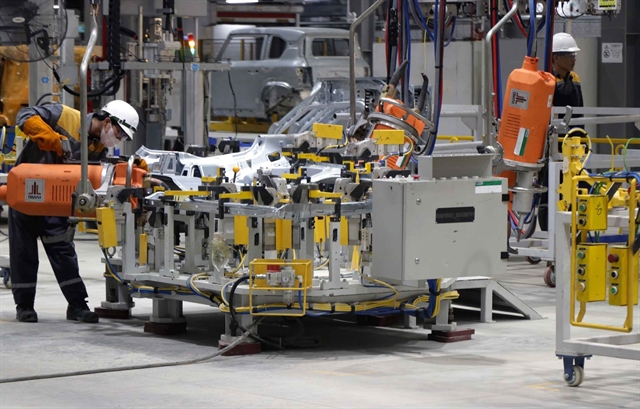 Society
Society

Sticking a ‘safe’ logo onto food products is one of the capital city’s recent efforts to fight off unsafe food, but the public is questioning its effectiveness.
 |
| Market management officials examine food products at a supermarket. — VNA/VNS Photo Vũ Sinh |
HÀ NỘI — Sticking a ‘safe’ logo onto food products is one of the capital city’s recent efforts to fight off unsafe food, and the public is discussing and debating its effectiveness.
Trần Thắng Mỹ owns a traditional nem chua (fermented pork roll) and giò chả (Vietnamese ham and sausage) store on the capital city’s Trần Xuân Soạn Street. It is a family business that originates from the Ước Lễ craft village, which specialises in making giò chả.
The store is the only place where Mỹ sells his signature products, but he said that there are other units who produce similar products and use his brand logo. The stores advertise widely on social media, creating unhealthy rivalry, he said.
“Their pork has unclear origin and has not been quarantined. They don’t know the secrets of our craft, yet they impersonated us and damaged our brand,” he said.
Mỹ said his family was excited to learn city’s authorities will examine his products and consider allowing him to use the food safety logo on products.
“It is essential that our safe products are recogniseable,” he said. “It will help us maintain our brand and the credibility of the family business.”
On the other hand, Lê Thị Tuyết, a housewife in Hà Đông District, appeared suspicious of the method.
“Will the logo really help us identify safe food products? Food businesses can still sell outdated products and products of unclear origin despite having the logo on their products,” she said.
“This sort of method will only benefit consumers if it is supervised carefully,” she added.
A representative from the city’s Department of Trade told the Tiền Phong (Vanguard) newspaper that the logo will help citizens identify safe food products and facilitate safe food management.
The trade sector is responsible for examining supermarkets and food businesses and determining whether they are qualified for a logo, he said.
The food businesses under regulation include chains of commercial centres, supermarkets and food stores whose products and trade activities have been certified as following the food safety criteria, he added.
Food businesses who wish to be examined by the trade authorities and receive the food safety logo must submit a registration form--which confirms their request for examination--to the trade department, the official said.
“The department will then conduct examinations,” he said. “If their products are qualified, they department will issue a certificate for use of food safety logo; and from then they can print the logo on their business signs,” he said.
Exhaustive management
Vũ Vĩnh Phú, chairman of the Hà Nội Supermarket Association, approves of the method but said that unsafe food is still able to sneak in though food products distributed at supermarkets, commercial centres and convenient stores are bearing several types of logo on their packages.
He said that a safe food production chain should be organised.
“The root of the problem will not be solved if we stick a ‘safe’ logo on a pack of pork but the meat itself is unsafe,” Phú said.
“Preferential policies should be developed for consumption units so that we can avoid going through intermediaries,” he said. “Food products will only be completely safe when they are supervised from the production phase to the distribution phase.”
Nguyễn Duy Hồng, an official from the Hà Nội Plant Protection branch, said that the food safety logo should clarify the origin of the food products in accordance with the Law on Product and Goods Quality, especially raw food.
“Sticking logos and stamps onto products will only solve the issue at a micro level. Unsafe, dubious but cheap vegetables sold at markets can still outweigh fresh ones that carry the food safety logo,” he said.
“Products sold at markets must also have clear origin and can only be sold if they meet food safety regulatory requirements,” he added. “Production enterprises and units must also take responsibility for the products they produce and sell.” — VNS